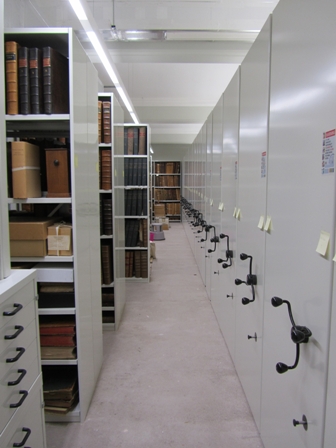It is six months since I last blogged about my own major project, the new Accreditation Programme for Archive Services. Then, I was introducing the pilot we were about to launch and describing what we hoped would come out of that process. Today, I can reflect on what we have learned from the pilot.
I listed three main aims for the pilot:
- Working out the kinks
- Getting the guidance as good as it can be
- Making sure that one size fits all
We recruited 20 different archive services from England, Scotland, Wales and Northern Ireland to achieve this. They represent a huge range of service types, from national institutions – The National Archives itself led the way as a pilot – to very small, privately-run archives who nonetheless can provide a public service to interested parties.

The strongroom at Exeter Cathedral Library and Archives, one of our pilot services
We worked with business archives, who often have serving internal users as a priority; archives in museums, where we needed to review how this new programme works with the existing scheme for museum accreditation; and we were very pleased to have a volunteer from the audio-visual archives sector who tested how the principles of archive service accreditation would work with their different media. So we gave ‘one size fits all’ a good workout.
What we heard back
Of the 20 services who began the pilot, all 20 were able to make a return, despite having to work to a tight timescale of just three months to help us launch the programme on schedule. That gives us real assurance that the process is not too burdensome. We recommend that once the scheme is live, archive services make it part of their long term planning and development, rather than setting an artificially short deadline like this.
The feedback we have had overall has been very positive, with only a couple of elements of the draft standard really needing to be rethought. There has been plenty of feedback about the detail, though, especially requests for additions and clarifications to the guidance. The applicants have also done that invaluable thing: tested the application form really thoroughly, in the way you never quite can until you’re trying to fill it in with live data. So we know there are plenty of changes and tweaks we can make to improve the process and the applicants’ experience. We are also looking now at making sure we support programme assessors to give consistent feedback – a challenge, as there are quite a few of us assessing behind the scenes!
Some examples of the feedback we have had include:
- Some of the terminology didn’t work for us as a business archive
- Please spell out all the acronyms!
- Does the information about buildings need to cover material held off site?
- This section is geared too much towards the traditional onsite visitor and needs to offer more scope to talk about online services
- Our management arrangements are more complicated than the application form allows for
- It would be good to include a description of what to expect from the site visit in the guidance document
- We have Tiny Tag readings for every strongroom for every month, so two years’ worth amounts to over 200 sheets of A4 graphs. Do you really want all these?!
And, more than anything: We need more free text space to explain our situation. The pilot has underlined once more how varied the archive landscape is, and how superficially similar services may have very different arrangements in practice.
We are taking all of this on board. When the revised documentation is published in summer, you should see changes based on these and many other pieces of feedback.
The National Archives’ experience
As I mentioned, The National Archives is a participant in the pilot, becoming one of the first UK archives to give the scheme a workout. Peter Brooker and Lee Oliver worked together to complete The National Archives’ application and were interviewed for ARC magazine along with several other pilot participants. You may be interested to read their views.
Why did The National Archives become part of the pilot?
We felt it was important to demonstrate our commitment to accreditation by participating. Being part of the pilot means we can share our experience of other benchmarking and improvement schemes for the good of the whole archive sector.
How are you finding the pilot?
It’s going surprisingly smoothly! We’ve created a massive spreadsheet to track responses as we’re working across so many different teams. It has also been a spur to make sure that we review our policies on schedule.
Is there anything you’ll be feeding back specifically?
Some of the draft questions appear to assume we’re operating a largely paper-based service, and we’ve had to insert responses relating to our extensive digital delivery mechanisms. We’d also like to see an opportunity to give some qualitative information on the contribution of volunteers – we think they bring more value to the organisation than is captured in raw numbers.
Any particular challenges about completing the application for such a large organisation?
We have multiple sites, and we’ve made the assumption that those at Norwich and Petty France (which contain only office functions) are out of scope. We’ve had to ensure that we refer to arrangements for the material outstored at Deepstore, which is definitely within scope. We’re also building a portfolio of evidence as we go along, so that if we are selected for a site validation visit, we’re well prepared in advance and know where everything is kept.